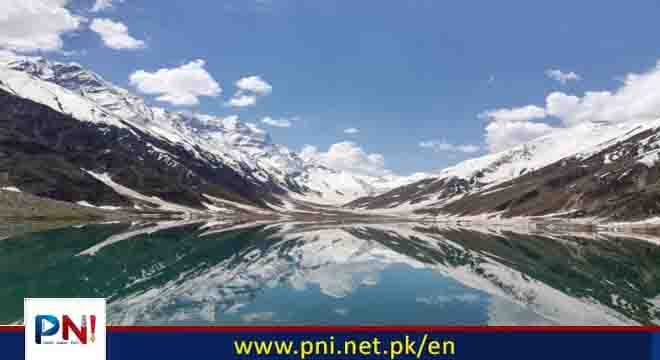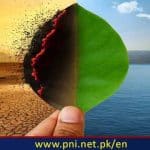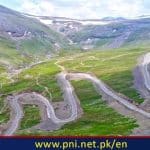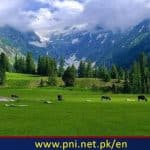PESHAWAR, Aug 11 : The arduous journey from Pakistan’s plain districts to the northern highlands of Khyber Pakhtunkhwa is instantly rewarded as the travelers encounter the breathtaking beauty of the famous Saiful Malook Lake.
This renowned lake, nestled amidst snow-capped peaks of the Malika Parbat range in Mansehra’s Kaghan Valley, captivates the visitors with its fairytale-like charm.
Spanning 1.06 square miles with a depth of 113 feet and sitting at an elevation of 3,224 meters above sea level, Saiful Malook’s oval shape with crystal-clear and greenish-blue waters leave an indelible mark on the hearts of millions of tourists each year.
Revered as a lake of legends and princes, Saiful Malook is enveloped by the serene mountains of Malika Parbat in upper Kaghan, offering a peaceful retreat to tourists from the hustle and bustle of everyday life.
Named after the Persian Prince Saiful Malook, the lake attracts both international and local tourists, particularly during the summer months when its pleasant climate and cascading waterfalls from nearby glaciers add to its allure.
The lake is immortalized in Sufi poet Mian Muhammad Bakhsh’s epic, “Fairytale of Saiful Malook,” which recounts the prince Saiful Malook quest for the fairy princess Badriul Jamala, a journey marked by enchanting stories and unfulfilled longing.
Though Pakistan boasts numerous stunning lakes like Ansoo, Lalusar, Dudipastar, and Sheosar, Saiful Malook stands out for its unique blend of fairytales, striking beauty, and pristine waters.
Manzoorul Haq, a former Pakistani ambassador, attested to the lake’s exceptional charm, citing its lasting impression compared to other global lakes destinations.
In the today’s digital age, there is a growing recognition of the potential for leveraging social media to enhance mountains and eco-tourism as well as archeology for economic development.
Abu Zafar Sadiq, President of the Alpine Club of Pakistan, highlighted how the growing digital and social media can transform the tourism landscape in Pakistan.
“Saiful Malook and similar breathtaking tourism sites offer stunning vistas and significant economic promise for Pakistan subject to government patronage.
Despite its immense potential, he said Pakistan’s tourism sector had struggled to reach its full economic potential mainly due to natural calamities, terrorism and COVID-19.
In 2017, tourism contributed only $8.8 billion, or 2.9% of GDP, a stark contrast to the $15 billion, or 5.7% of GDP, in 2019. The COVID-19 pandemic and security issues exacerbated these challenges, with a notable decline in tourism revenue and employment in Pakistan.
Abu Zafar emphasized the importance of embracing digital innovations, such as virtual tours and social media campaigns, to attract more visitors.
He advocated for hiring digital professionals and utilizing platforms like GPS and artificial intelligence to promote Pakistan’s diverse tourism offerings.
The potential for tourism growth is evident in Pakistan, with the “One Belt, One Road” initiative and China-Pakistan Economic Corridor (CPEC) playing pivotal roles in improving infrastructure and boosting tourism, transport and hospitality industries.
Ambassador Manzoor also suggested that developing attractions like a chairlift between Naran and Saiful Malook could generate significant revenue and enhance the socio-economic conditions of people of the region.
However, challenges remain, including environmental concerns. Efforts to improve waste management and enhance facilities are crucial for preserving the natural beauty of Saiful Malook and other lakes of Pakistan.
Increased litter bins, sanitary workers, and improved parking facilities are among the necessary measures to maintain the lake’s allure.
Professor Naveed Farooq, a lecturer at Abdul Wali Khan University Mardan, underscored the importance of digital showcasing of all lakes for attracting foreign tourists.
“Saiful Malook Ansoo and Mahudhand lakes are gems of Pakistan. Utilizing digital technology to highlight these treasures can draw international visitors in droves and further boost tourism.”
The KP Wildlife Department, which oversees Saiful Malook and Lulusar lakes as national parks, is working to ensure sustainable protection and improved tourist facilities.
Future developments, such as a chairlift project and enhanced service areas, aim to elevate the tourist experience while supporting local economies.
Overall, as Pakistan continues to enhance its digital presence and infrastructure, Saiful Malook Lake remains a symbol of the nation’s rich natural and cultural heritage, poised to attract and inspire millions of visitors from around the world.
Follow the PNI Facebook page for the latest news and updates.








